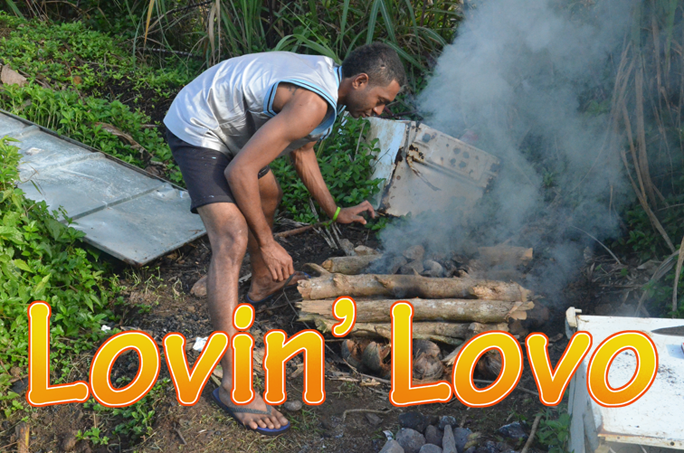Lovin' Lovo
You may have figured out by now that I
really don’t hang out in the kind of locations that most tourists
enjoy. The reason for that is I don’t enjoy those kinds of
places. But, from time to time, I have to bite the bullet and go
where I really don’t want to go in order to see what I really do want to
see.
That’s why I visited Pacific Harbor.
It’s a very exclusive community with expensive homes, manicured lawns, and over-priced everything. Sad to say, it’s the destination for so many people who visit Fiji. And in my very biased opinion, they miss out entirely on the experience they should have.
So, why was I there? Three times?
There is a place there called the Fiji Arts Village. Supposedly, at this destination, you can see cultural troupes dance and experience a lovo. Cultural troupes are always on my list of things to see everywhere I go. I’m always on the look-out for a unique portrait. Lovo, on the other hand, is a unique kind of Fijian meal that I didn’t think I was going to experience any other way. So, I journeyed to the Fiji Arts Village, three times, and each day I was informed there were not enough bookings for anything. I thought I was going to miss out on this experience entirely.
I didn’t count on going to Kuku.
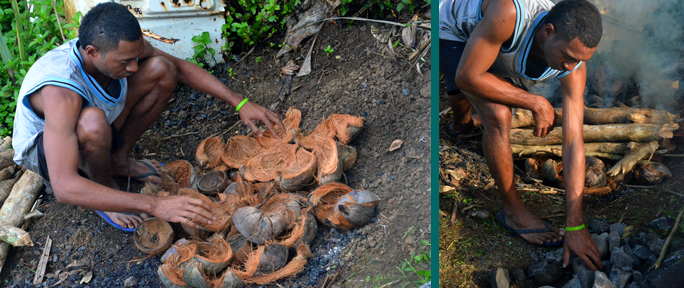
That’s why I visited Pacific Harbor.
It’s a very exclusive community with expensive homes, manicured lawns, and over-priced everything. Sad to say, it’s the destination for so many people who visit Fiji. And in my very biased opinion, they miss out entirely on the experience they should have.
So, why was I there? Three times?
There is a place there called the Fiji Arts Village. Supposedly, at this destination, you can see cultural troupes dance and experience a lovo. Cultural troupes are always on my list of things to see everywhere I go. I’m always on the look-out for a unique portrait. Lovo, on the other hand, is a unique kind of Fijian meal that I didn’t think I was going to experience any other way. So, I journeyed to the Fiji Arts Village, three times, and each day I was informed there were not enough bookings for anything. I thought I was going to miss out on this experience entirely.
I didn’t count on going to Kuku.

Fire
preparations
Sunday is traditionally a big day for
family events in Fiji. On family occasions, or when you have an
American artist in your midst, you need a lovo. I did my
research. I knew what it was. A lovo is a traditional meal
which is cooked in underground ovens called lovo pits. The Nalawa
family had their own pit, and I’m going to guess that most families in
Fiji do as well.
The task fell on Simi’s shoulders to introduce me to lovo, step-by-step, and he very patiently let me document what he did throughout the process. Food in a lovo is cooked over hot rocks. In order to get them hot, a fire is made with coconut husks, sticks, and firewood. I started the fire with a little bit of gasoline and a match. I asked Simi if he could make a fire the traditional way without gas or matches. He said that only older generations knew how to do that. He preferred matches, and so did I.
Once the fire starts, rocks are placed on top of the flames. They need to get hot, so you need to wait until their color changes from dark to white. When the fire is ready, leftover firewood is pushed aside before meat wrapped in palm fronds or banana leaves is placed in the center. In my lovo experience, we had fish uniquely wrapped in a woven palm frond. But, just as matches make life a little easier, the chicken was completely wrapped in foil. Thank goodness for modern conveniences! The meat, which is called a relish, could also include seafood or pork. Before my time in Fiji was over, I attended another lovo where an entire pig was used. Yes, you read that right. I missed out on the Fiji Arts Village and still had two lovo experiences!
The meat dishes, relishes, are surrounded by the starches. My starch of choice is potatoes. That didn’t happen at a lovo. We had freshly harvested cassava, direct from the garden. We also lined the lovo with taro and sweet potatoes. Other starches could include yams, manioc, and breadfruit. And, the most unique dish in my mind was palusami, cooked in coconut half-shells. Of course, the recipe is coming.
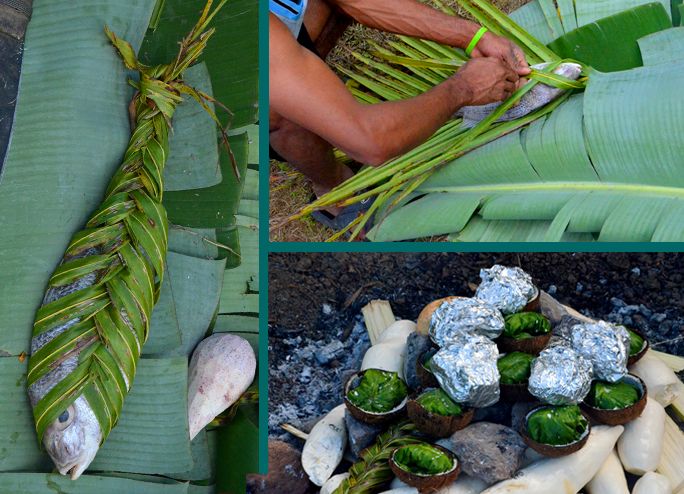
So, when everything is ready to cook, you don’t stand around the grill and watch a chef apply barbecue sauce and turn the meat. You bury it. Remember, I said that a lovo is an underground oven in a pit. First palm fronds are placed over the flames. Next, banana leaves cover the fronds. Another little modern convenience included heavy-duty plastic rice bags. They didn’t melt. They just helped seal the deal. Finally, the whole pile is covered with dirt and left to smolder and cook for three hours.
During those three hours, I toured a local village with some of my hosts. Simi prepared an absolutely amazing amount of fresh coconut for other dishes not cooked underground. He sat on a unique scraping tool, which I really wanted to bring home with me, and scraped out the coconut meat with a round, pointed grinder on the tip of the tool.
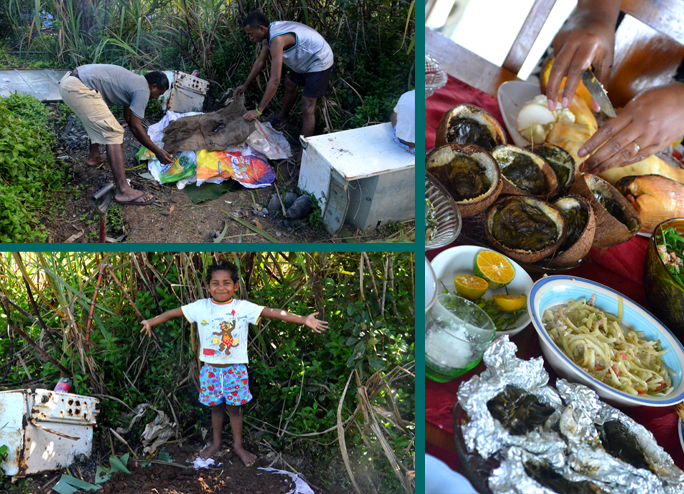
The meal looked like a Thanksgiving feast, Fijian style. And, I was so very thankful for the experience.
So, I went to Pacific Harbor for a lovo experience that would have satisfied, because I knew it was the best I could find in the short amount of time I had in Fiji. What I found instead was more than I ever could have expected with more family and friends than I ever imagined. It is certainly the reason why I wander off the regularly beaten paths that most people tend to travel.
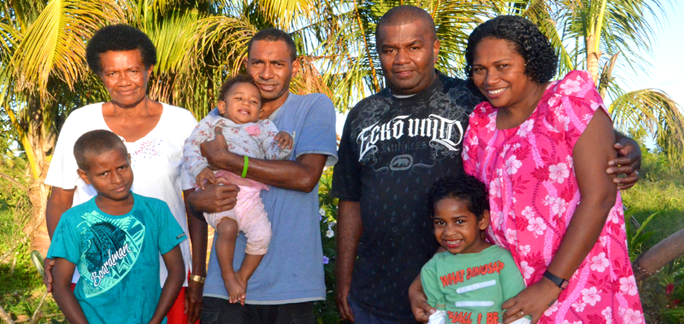
Copyright 2016 by Phillip Martin All rights reserved.
The task fell on Simi’s shoulders to introduce me to lovo, step-by-step, and he very patiently let me document what he did throughout the process. Food in a lovo is cooked over hot rocks. In order to get them hot, a fire is made with coconut husks, sticks, and firewood. I started the fire with a little bit of gasoline and a match. I asked Simi if he could make a fire the traditional way without gas or matches. He said that only older generations knew how to do that. He preferred matches, and so did I.
Once the fire starts, rocks are placed on top of the flames. They need to get hot, so you need to wait until their color changes from dark to white. When the fire is ready, leftover firewood is pushed aside before meat wrapped in palm fronds or banana leaves is placed in the center. In my lovo experience, we had fish uniquely wrapped in a woven palm frond. But, just as matches make life a little easier, the chicken was completely wrapped in foil. Thank goodness for modern conveniences! The meat, which is called a relish, could also include seafood or pork. Before my time in Fiji was over, I attended another lovo where an entire pig was used. Yes, you read that right. I missed out on the Fiji Arts Village and still had two lovo experiences!
The meat dishes, relishes, are surrounded by the starches. My starch of choice is potatoes. That didn’t happen at a lovo. We had freshly harvested cassava, direct from the garden. We also lined the lovo with taro and sweet potatoes. Other starches could include yams, manioc, and breadfruit. And, the most unique dish in my mind was palusami, cooked in coconut half-shells. Of course, the recipe is coming.

So, when everything is ready to cook, you don’t stand around the grill and watch a chef apply barbecue sauce and turn the meat. You bury it. Remember, I said that a lovo is an underground oven in a pit. First palm fronds are placed over the flames. Next, banana leaves cover the fronds. Another little modern convenience included heavy-duty plastic rice bags. They didn’t melt. They just helped seal the deal. Finally, the whole pile is covered with dirt and left to smolder and cook for three hours.
During those three hours, I toured a local village with some of my hosts. Simi prepared an absolutely amazing amount of fresh coconut for other dishes not cooked underground. He sat on a unique scraping tool, which I really wanted to bring home with me, and scraped out the coconut meat with a round, pointed grinder on the tip of the tool.

The meal looked like a Thanksgiving feast, Fijian style. And, I was so very thankful for the experience.
So, I went to Pacific Harbor for a lovo experience that would have satisfied, because I knew it was the best I could find in the short amount of time I had in Fiji. What I found instead was more than I ever could have expected with more family and friends than I ever imagined. It is certainly the reason why I wander off the regularly beaten paths that most people tend to travel.

my hosts,
the Nawalas
